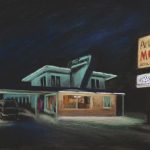Susan Elena Esquivel
Sculptural Ceramics and Mixed Media
I am influenced by the beauty and simplicity of nature, particularly, processes such as erosion, decay and the evidence of time passing By handbuilding or altering thrown parts of porcelain I can capture organic forms at a various points in their lifecycle. The firing process is very integral to the final outcome. I have chosen firing methods that invite the element of chance and let the natural elements, fire, wood, the weather, everything that occured at the time of the firing have an impact. Saggar firing – A saggar is a box made of bricks housed within a gas kiln. When a piece is bone dry, a fine clay slip called terra sigillata is brushed on to the surface and burnished to create a smooth stonelike surface. It is then bound with copper wire and placed into the saggar with seaweed, hay, banana peels, sawdust, salts, and oxides. The slow firing process allows the combustibles and the fire to leave behind unique marks upon the porcelain, making each piece one of a kind. Lastly, the pieces are finished with a wax coating to enhance and protect the atomspheric surface. Soda/Wood firing sums up my beliefs about the spiritual nature of art. I fire with 10 other artists in an anagama kiln which is a traditional Japenese hillside style kiln. The kiln takes 3-4 days to load and is stoked with wood for 7-10 days, cooling takes another 7-10 days. The surfaces are left bare or glazes used minimally so that the wood ash will create a natural surface of it’s own. Kiln firing in Japan has always been regarded as a natural process. Their idea of kami, the spirit or spiritual quality infused in inanimate as well as animate objects is well known. The sculpture may have it’s kami as a result of all the events that shaped it. The collaboration with the process has an organic unity in which the effort of the artist emerges and a part of the person is embodied in the result. Therefore, the power and beauty of saggar and wood fired pieces can be attributed to their emergence as moments in time rather than static objects. The idea that they can never be reproduced has great signficance for me and is a very important aspect of my work.
My art career began with an BFA in graphic design and painting. After working as an art director for many years, I decided to follow my love of painting. I enrolled in the Diploma Program at the School of the Museum of Fine Arts in Boston. However, a trip to a Barcelona changed my direction, where the work of Gaudi, Juan Artigas, Miro and Picasso inspired me to work in clay. After the Museum School, I studied at Radcliffe College with Master Potter Makoto Yabe, who taught me an appreciation for natural occurences and a reverence for things we cannot control. These elements continue to strongly influence my work. In 1996, I set up my own studio in Boston’s South End and named it Catalunya Studio in celebration of the artistic spirit I found in Spain and my Spanish roots. In 1998, I moved to Martha’s Vineyard and spent 7 years living and working there. The natural beauty of the island had a profound effect on my work. In 2005, Catalunya Studio moved from the sea to the mountains and is now part of the Cottage Street Studios in Easthampton, Massachusetts. My work is exhibited internationally in galleries, museums and art festivals such as the American Craft Council, The State of Clay National, Lakefront Festival of the Arts, The Decordova Museum, The Field Gallery, and is held in many private and corporate collections. I have also been featured in national publications such as Ceramics Monthly, Crafts Business Magazine, Martha’s Vineyard Magazine and the Boston Globe.


